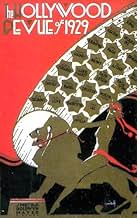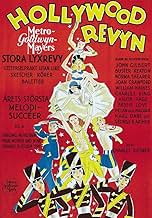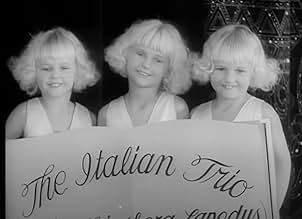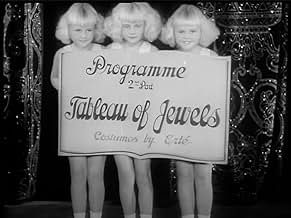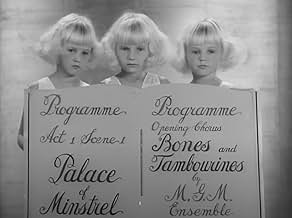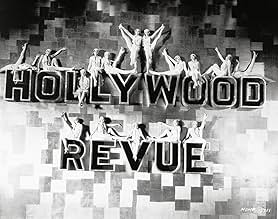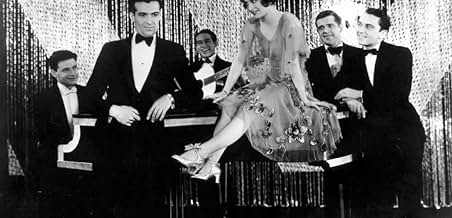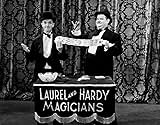AVALIAÇÃO DA IMDb
5,7/10
2,5 mil
SUA AVALIAÇÃO
Adicionar um enredo no seu idiomaAn all-star revue featuring MGM contract players.An all-star revue featuring MGM contract players.An all-star revue featuring MGM contract players.
- Direção
- Roteiristas
- Artistas
- Indicado a 1 Oscar
- 1 vitória e 1 indicação no total
Cliff Edwards
- Ukelele Ike
- (as Ukulele Ike)
Nils Asther
- Nils Asther
- (cenas deletadas)
Brox Sisters
- The Brox Sisters
- (as Brox Sisters - Singing Trio)
- Direção
- Roteiristas
- Elenco e equipe completos
- Produção, bilheteria e muito mais no IMDbPro
Avaliações em destaque
This film will not get a good reception from most modern audiences, and certainly much of the film shows its seventy plus years, but this is a delight for some of us who see the '20s as a golden age, and this movie as a small window into it. It is also a humble reminder that in seventy-five years or so, what we consider entertainment will hold little or no interest to mass audiences.
If you are familiar at all with who the people are (Jack Benny, Joan Crawford, Cliff Edwards, Buster Keaton, etc.), the film is worth seeing. All of these people were one of a kind, not to be replicated by big name performers of today (great stars in their own right, but sorry, folks, they just don't have the class!). Just to see Joan Crawford as a young and beautiful woman is worth watching the film!
Technically, of course, the movie is what it says it is--a revue--intended to show audiences that their favorite silent stars can function in the new medium of sound. That purpose fulfilled (more or less), the film now might seem to have no point. The passage of time and the loss of context have made some of the humor corny (a term, by the way, from that period). The editing is clumsy (we have learned from their mistakes), but the personages themselves, and some of the song and dance, are better than anything we have today, and could not be duplicated.
I'd rather watch this than anything on the screen now.
If you are familiar at all with who the people are (Jack Benny, Joan Crawford, Cliff Edwards, Buster Keaton, etc.), the film is worth seeing. All of these people were one of a kind, not to be replicated by big name performers of today (great stars in their own right, but sorry, folks, they just don't have the class!). Just to see Joan Crawford as a young and beautiful woman is worth watching the film!
Technically, of course, the movie is what it says it is--a revue--intended to show audiences that their favorite silent stars can function in the new medium of sound. That purpose fulfilled (more or less), the film now might seem to have no point. The passage of time and the loss of context have made some of the humor corny (a term, by the way, from that period). The editing is clumsy (we have learned from their mistakes), but the personages themselves, and some of the song and dance, are better than anything we have today, and could not be duplicated.
I'd rather watch this than anything on the screen now.
MGM used to boast that they had more stars than were in the heavens. This transitional picture shows some "stars", people who still have name recognition. Some of the performers were near the end of their career, some at the beginning, and others, probably did not have much of a career before or after this.
There's no real plot - it's pretty much a variety show hosted by Conrad Nagle and Jack Benny. There are some historical moments here - the first performance of "Singing in the Rain", the alleged cause of John Gilbert's career nosediving, Joan Crawford singing and dancing, some slapstick from Laurel & Hardy. There are appearances by the stunningly beautiful Anita Page who looks kind of sad while Conrad Nagle appears to be singing to her. William Haines, just before Louis B. Mayer ended his acting career, eating part of Jack Benny's clothing. Bessie Love appeared to come from one of Jack Benny's pockets - she said there was a $100 bill in the pocket, Benny quips that it's not his suit.
Parts of this was the inspiration of the movie "Singing in the Rain", which was done 20+ years later.
The pluses to this: some color sequences, including the closing performance of "Singing in the Rain", a weird dance sequence by Buster Keaton, who remains mute, and it's a great glimpse into Hollywood as it transitioned from the Silent Era to the age of "talkies". One interesting thing was the cameras weren't as static as they were for many of the early "talkies". There's also a kind of experimental dance sequence where it appears that they used some of the negatives in place of the processed film.
Some of the minuses are it wasn't a smooth transition from the Silent Era to the age of "talkies" - the sound quality is very inconsistent. Some people sounded kind of muffled, some people's voices weren't picked up very well. The version that was played by TCM on 8/4/08 wasn't closed captioned, so if you can't understand what someone is saying or singing, you don't have any captioning to help you out.
This is a good movie if you are interested in relatively early movies - it's almost 80 years old. It's also a chance to see some performers that didn't appear very often.
There's no real plot - it's pretty much a variety show hosted by Conrad Nagle and Jack Benny. There are some historical moments here - the first performance of "Singing in the Rain", the alleged cause of John Gilbert's career nosediving, Joan Crawford singing and dancing, some slapstick from Laurel & Hardy. There are appearances by the stunningly beautiful Anita Page who looks kind of sad while Conrad Nagle appears to be singing to her. William Haines, just before Louis B. Mayer ended his acting career, eating part of Jack Benny's clothing. Bessie Love appeared to come from one of Jack Benny's pockets - she said there was a $100 bill in the pocket, Benny quips that it's not his suit.
Parts of this was the inspiration of the movie "Singing in the Rain", which was done 20+ years later.
The pluses to this: some color sequences, including the closing performance of "Singing in the Rain", a weird dance sequence by Buster Keaton, who remains mute, and it's a great glimpse into Hollywood as it transitioned from the Silent Era to the age of "talkies". One interesting thing was the cameras weren't as static as they were for many of the early "talkies". There's also a kind of experimental dance sequence where it appears that they used some of the negatives in place of the processed film.
Some of the minuses are it wasn't a smooth transition from the Silent Era to the age of "talkies" - the sound quality is very inconsistent. Some people sounded kind of muffled, some people's voices weren't picked up very well. The version that was played by TCM on 8/4/08 wasn't closed captioned, so if you can't understand what someone is saying or singing, you don't have any captioning to help you out.
This is a good movie if you are interested in relatively early movies - it's almost 80 years old. It's also a chance to see some performers that didn't appear very often.
I have seen this film a few times and always think boy they were the good old days. In 1929, for their first talking film, MGM put together this lavish, all-star revue with absolutely no plot. It contains guest appearances from many of MGM's top silent film stars. If you do ever see this you will notice many of them did not make it through the transition of the talking pictures. Joan Crawford stands out doing her horrible dance and singing routine, but the best is the technicolor SINGIN' IN THE RAIN finale. This is a must for any film buff.
This is an amazing film, it has amazing special effects, it shows who made the transition from silent to talkie and who didn't, it has scenes in color (two-strip technicolor from what I understand), and it has some of the cutest costumes of any musical.
Some of the highlights of the movie are Joan Crawford song and dance number, which is too cute for words, and not terrible as another IMDB commenter would have you believe.
The Buster Keaton snake charmer dance is absoluetly hilarious. The Betty Johnson hiding in Jack Benny's pocket is pretty cute.
And the Singing in the Rain number is great, with it's simple yet beautiful art deco set and it's great reflective floor textured with the pitter patter of rain.
If you ever get a chance to see this film, take advantage of it. It is so strange to see every MGM start (except Garbo and Lon Chaney) in the same film, especially since many of them didn't continue making a lot of talking pictures.
Outstanding!!!!!
Some of the highlights of the movie are Joan Crawford song and dance number, which is too cute for words, and not terrible as another IMDB commenter would have you believe.
The Buster Keaton snake charmer dance is absoluetly hilarious. The Betty Johnson hiding in Jack Benny's pocket is pretty cute.
And the Singing in the Rain number is great, with it's simple yet beautiful art deco set and it's great reflective floor textured with the pitter patter of rain.
If you ever get a chance to see this film, take advantage of it. It is so strange to see every MGM start (except Garbo and Lon Chaney) in the same film, especially since many of them didn't continue making a lot of talking pictures.
Outstanding!!!!!
Finally got around to seeing this on its recent outing on TCM, and despite the drawbacks - yes, it is slow-paced, yes, it is dated - there is a certain charm to it that makes it very enjoyable. I particularly liked the novelty acts and comedy stuff - Bessie Love, Marie Dressler, Laurel and Hardy and Buster Keaton's Egyptian lady. And the Gilbert/Shearer Romeo and Juliet section is worth sitting through the rest for anyway (despite its washed out colour, which oddly looked better in the little snippet showed in When The Lion Roars). I can't say I was disappointed with any of it - you get mind-boggling acrobats, you get weedy voiced Marion Davies, you get Jack Benny playing his violin and Conrad Nagel singing pretty well, and Charles King singing that hideous song about mothers, and Ukelele Ike, well, playing a ukelele, and Joan Crawford's ungainly dancing ... it's just a real treat, and nice to see from a technical pov that the sound isn't bad at all and despite its advanced age it is still watchable. A respectable 7 out of 10 I think.
Você sabia?
- CuriosidadesIn the "Singin' in the Rain" finale, Buster Keaton is shown carrying a small package in his left hand. This visual gag is a reference to Uneeda Biscuits, then a popular product made by Nabisco. The Uneeda Biscuit trademark showed a small boy wearing a yellow rain slicker and hat (similar to the outfits that the cast is wearing in this number) and walking home in the rain with a package of Uneeda Biscuits under his arm.
- Erros de gravaçãoAfter Cliff Edwards' opening number, one of the chorus girls in the background is chatting away with the girl next to her, when a sudden cut appears, and the same girl is now stone still (apparently the director told her in between to stop talking, and pay attention).
- Versões alternativasSome sources list the original running time of "Hollywood Revue of 1929" as 130 minutes. At least two sequences in the original roadshow version are missing from current prints: an opening recitation by the showgirls who are seen posing in the "Hollywood Revue" sign after the opening credits, and the appearance of Nils Asther, who assisted Jack Benny in introducing the final "Orange Blossom" number.
- ConexõesAlternate-language version of Wir schalten um auf Hollywood (1931)
- Trilhas sonorasSingin' in the Rain
(1929) (uncredited)
Music by Nacio Herb Brown
Lyrics by Arthur Freed
Played during the opening by The MGM Symphony Orchestra
Played on ukulele and sung by Cliff Edwards and The Brox Sisters; Danced by chorus
Sung by the major stars at the end
Principais escolhas
Faça login para avaliar e ver a lista de recomendações personalizadas
- How long is The Hollywood Revue of 1929?Fornecido pela Alexa
Detalhes
- Data de lançamento
- País de origem
- Central de atendimento oficial
- Idioma
- Também conhecido como
- The Hollywood Revue of 1929
- Locações de filme
- Empresa de produção
- Consulte mais créditos da empresa na IMDbPro
Bilheteria
- Faturamento bruto mundial
- US$ 5.277.780
- Tempo de duração
- 2 h 10 min(130 min)
- Cor
Contribua para esta página
Sugerir uma alteração ou adicionar conteúdo ausente


